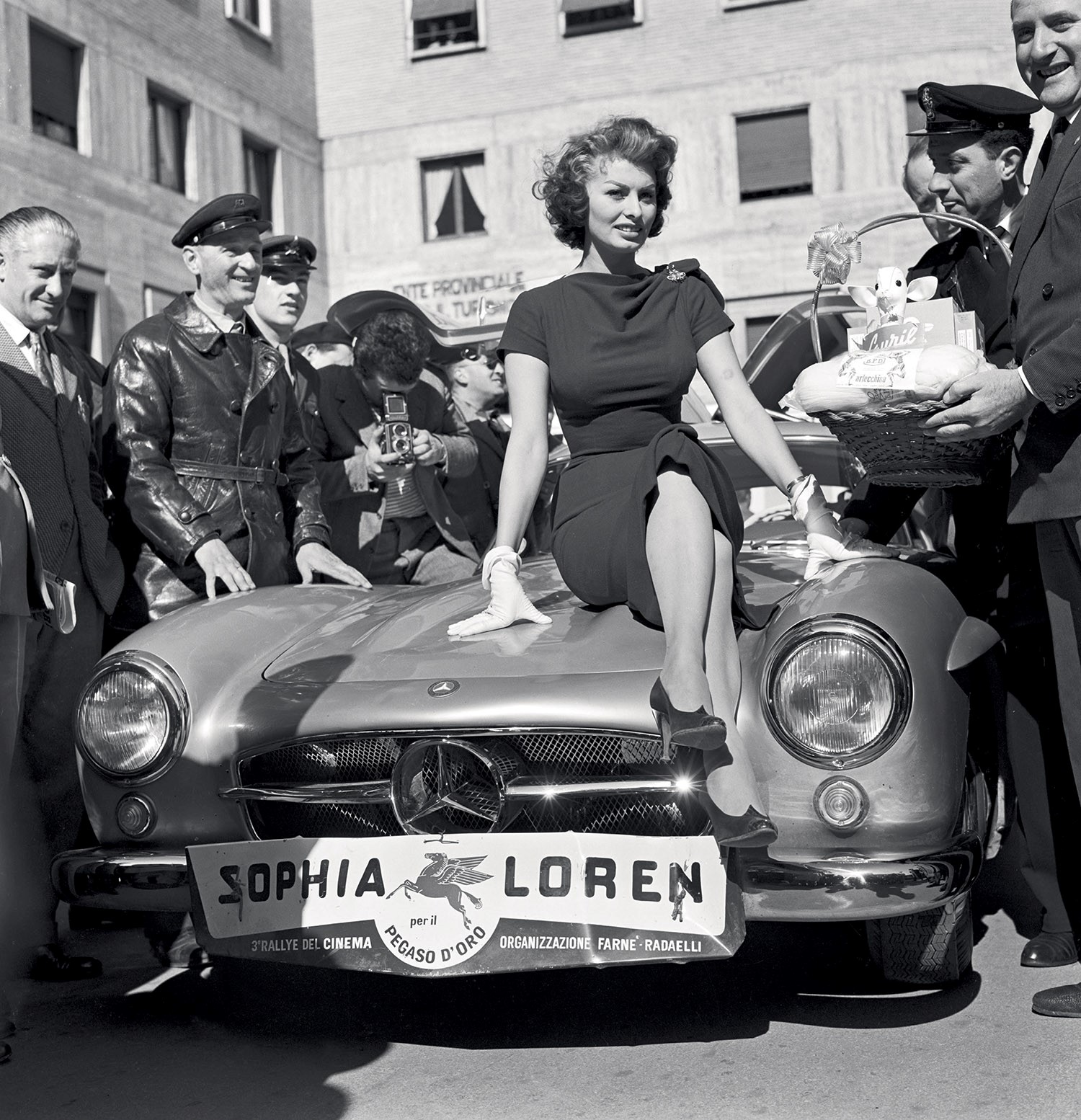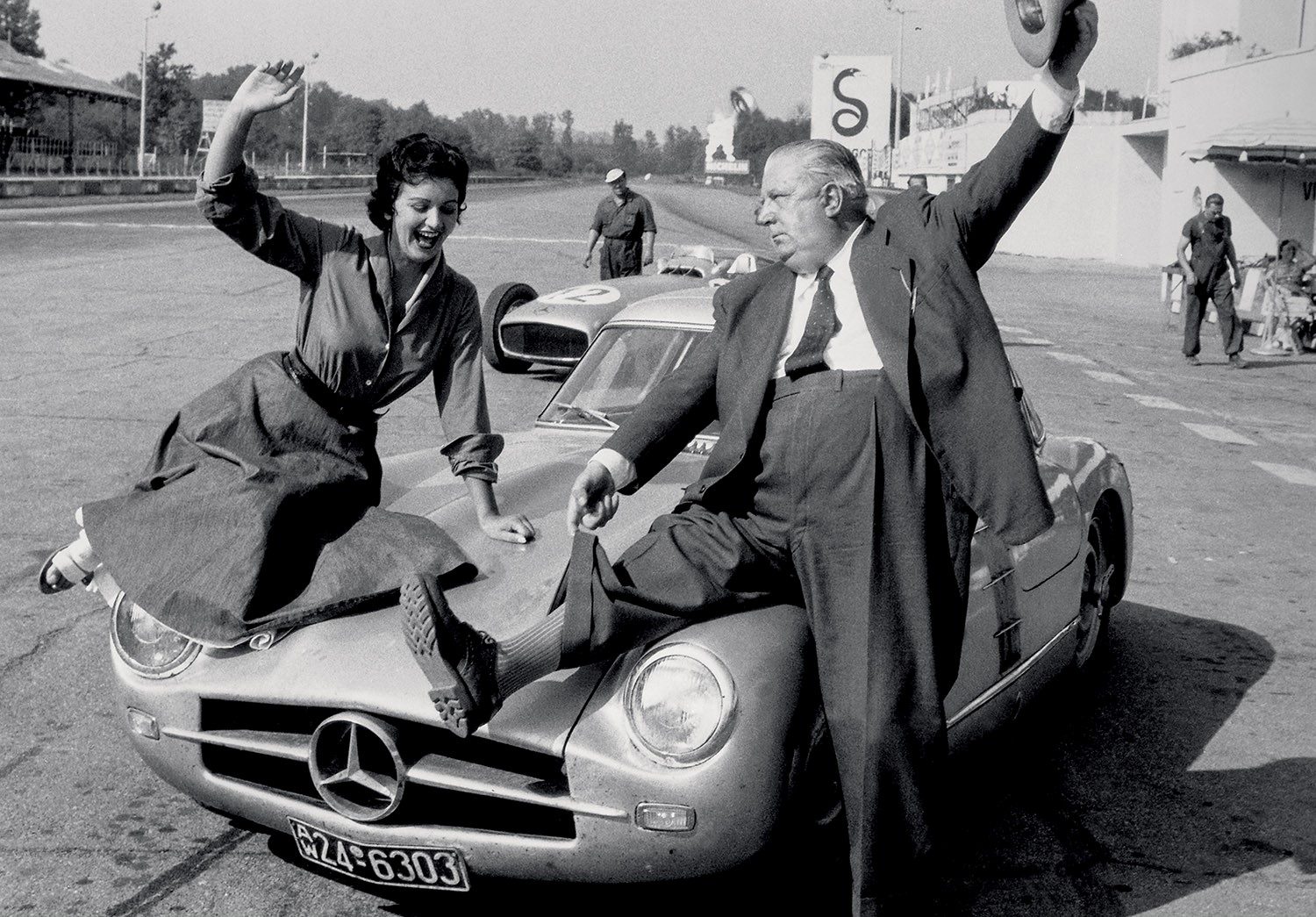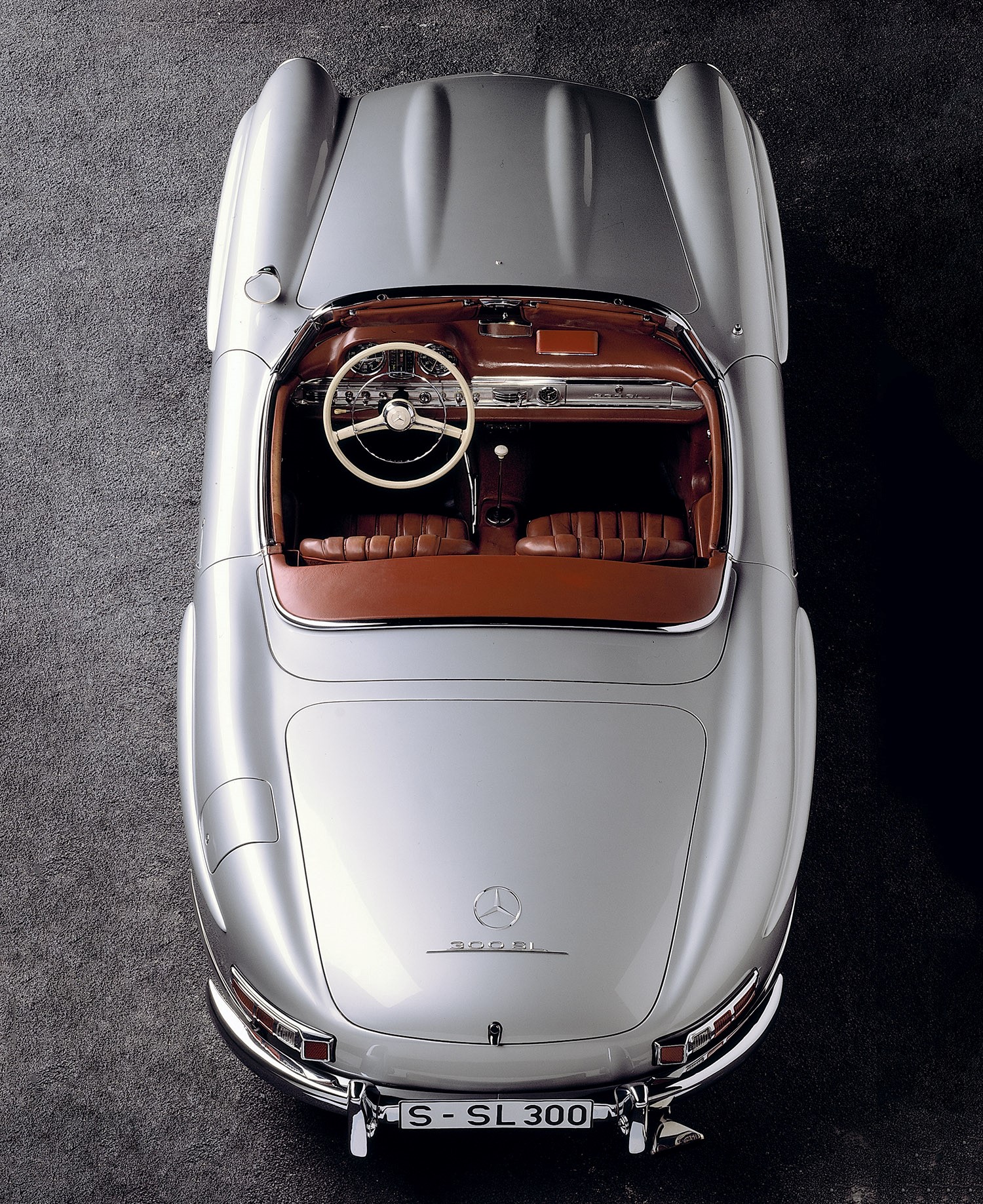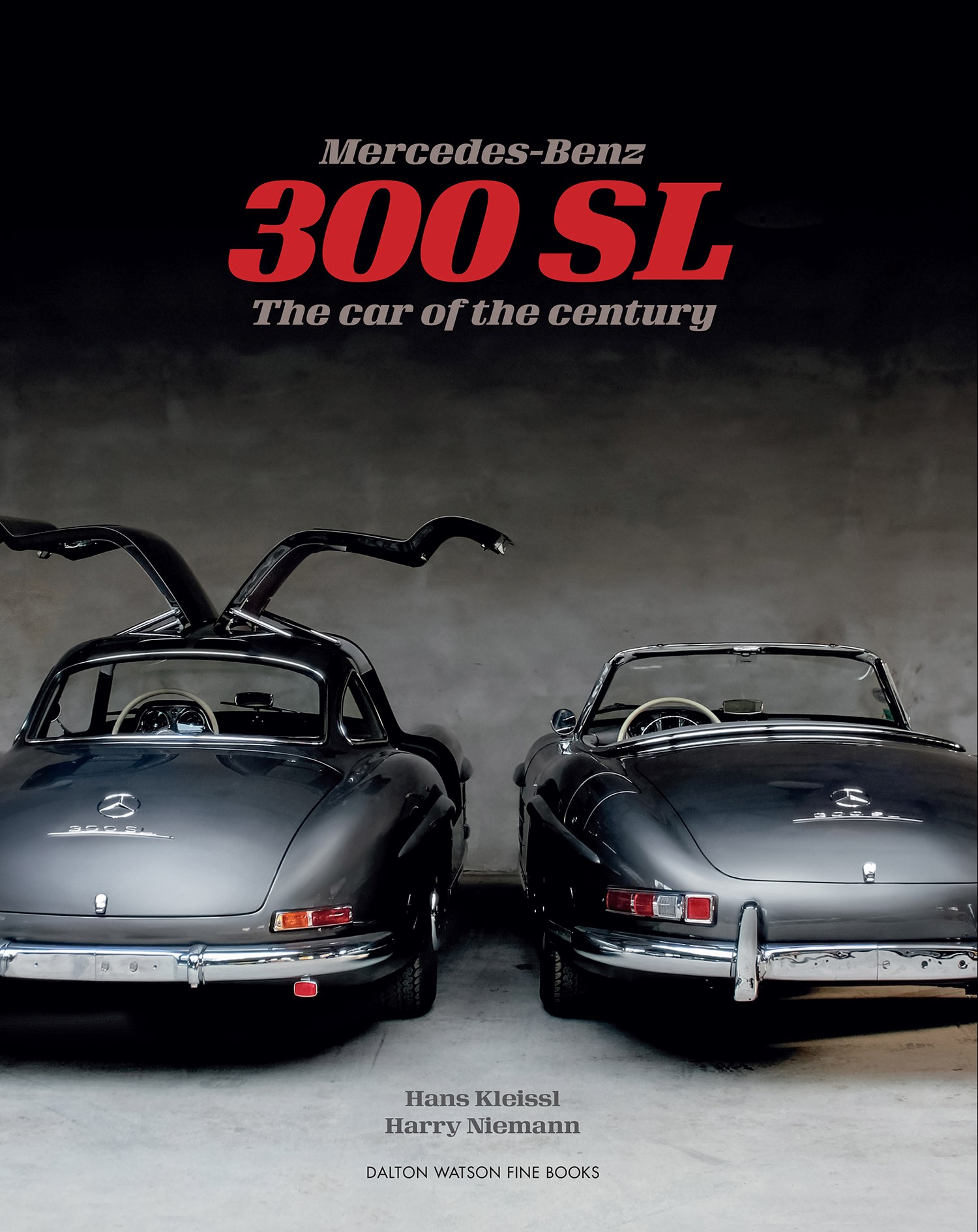Review by Pete Vack
Mercedes-Benz 300 SL: The Car of the Century
by Hans Kleissl and Harry Niemann
Hard cover in dust jacket
374 pages, 403 images
Our Price: $150.00
Shipping Costs: FREE SHIPPING TO USA AND UK. Shipping to all other countries will be charged one flat rate for first item, additional books in the same order are shipped for no additional s/h charge. Books available immediately in US and Europe. Delivery to the UK is pending.
Order here
Unexpectedly Pleasant
I offer my profuse apologies for the lead photo of Miss Scicolone, perched as she is on a Mercedes 300SL. No doubt she would have looked much nicer accompanied by a 250GT Berlinetta or an A6GCS 2000 Maserati. However, as we shall see, there is a reason for this.
The book from which that photo hailed is as interesting and charming as they come. Not as charming perhaps as Miss Scicolone, but for a book on German cars by German authors is it a delicious ride. We expected it to be similar to the dozens of other books available on the 300 SL and thought it would be typical Teutonic fair, all specs and tech. But as the authors stated in the introduction, “This book should be different, with no detailed technical accounts of the production phases, but rather it should convey the feelings of life and emotions associated with ownership of the car.”
And so it is. Yet every paragraph is packed with information, well written, informative, so a good deal of that techy stuff is still there to absorb but in an enjoyable fashion. The photos dominate, however, and take full advantage of the book’s large format, excellent reproduction and top-quality paper. Author Hans Kleissl knows his 300 SLs. He is the founder of HK Engineering, and a full third of the 300 SLs have passed through his hands. Co-author Dr. Harry Niemann managed the Mercedes-Benz AG Historical Archive from 1989 to 2008 and is the author of several books on Mercedes-Benz.
Easter Eggs
Despite a wandering manner, the book proceeds roughly chronologically, beginning with the postwar devastation, the 170 sedan, and a good bit of press on the 300 SL racing coupe of 1952, with enough detail to mention the fact that at Berne, on May 17th 1952, the three factory coupes were painted in “Easter egg” colors of red, light blue and green. Easter in 1952 was on April 13 however, and no further explanation was given for this unusual break with tradition.
The next stop features three super-light biographies of the 300 SL triumvirate; overall engineer Rudolf Uhlenhaut, fuel injection man Hans Scherenberg, and designer Friedrich Geiger, who did so much to make the car a classic.
Speaking of super light biographies, this sort of thing makes up the majority of the book; the authors search out an interesting owner, relate the story of the particular car, and provide ample, large, and excellent historical images that bring their stories to life. NBC (not CBS as the text has it) bandleader Don Ricardo made so much money he owned 20 300SLs, and in 1967 prepped his aluminum bodied Gullwing for a run at the Bonneville Salt Flats, setting a Class E GT record of 153.771 mph which stood for thirty-five years. Gunter Sachs gets a chapter, he of Fichtel Sachs on one side and Opel on the other could well afford to be a 300 SL owner and playboy.
José Meiffret was seeking to break a world bicycle speed record and did so, pedaling behind a Gullwing for a record speed of 204.778 kph. In one of the few glaring mistakes in the book, the chapter title got the mph and kph mixed up, with 204.778 mph in red print instead of kph. Seeing as Ricardo only managed 153 mph at Bonneville, one wondered how a 300 SL managed 204 mph with a bike in the back. The incongruity got our attention but not in the same manner as Miss Scicolone. A more realistic 124 mph was the actual speed, quite harrowing on a bike with wooden wheels and a chain with 130 links.
The 300 SL America
An interesting statistic was that roughly 80 percent of the 1400 Gullwings made and 70 percent of the 1858 Roadsters built were sold to the U.S., and one of the prime forces behind the creation of the car was of course Max Hoffman who suggested to Daimler Benz to build a sports car for sale in the U.S. A mechanic in California, Chuck Porter, thought he’d make something of a recent 300SL wreck, and came up with a car that looked amazingly like the Mercedes 300SLRs still winning all the races in Europe. It was reasonably successful in class but attracted more attention than trophies. And, in an unusual deal with Paul O’Shea, Uhlenhaut was ordered to have two very special SLS Roadsters to be built for SCCA competition, for one year only, 1957. Paul won his SCCA championship, both cars were hustled back to the factory and were never seen again. The cars that exist to today are replicas built on the model of the O’Shea SLS.
Celebrities
Now this is really lightweight social history, but good fun and we enjoyed it. For example, a chapter on German star Horst Buchholz, who will be remembered for his roles in “The Magnificent Seven” and opposite Pamela Tiffin in Billy Wilder’s “One, Two, Three” at the age of 24 had his 300 SL, the car of his dreams. Other Celebrities photographed with a 300 SL were Steve McQueen, Herbert von Karajan, Clark Gable, Anita Ekberg, Tony Curtis, and Yule Brynner. There is a good chapter on Porfirio Rubirosa, who raced Lancias, died in a Ferrari, but was also a good customer of Mercedes-Benz. Then there was the adventure with David Douglas Duncan and Pablo Picasso.
Appendixes include Tech Specs, 300 SL Modifications, Colors and Options, and a chapter on the racing successes of the 300 SL series.
Whether or not the 300 SL was the car of the century is arguable, but can you name another sports car that offered a space frame, independent suspension and fuel injection? Whatever you might think, the book is a light read (alas sometimes too light), but a worthy addition to the bookshelf for anyone interested in motoring in the 1950s.
We return to our Miss Scicolone. According to the authors, whose facts seem uncontestable, when Miss Scicolone became Mrs. Carlo Ponti, he gave her, among other things, a Mercedes 300 SL Roadster, so the connection with the marque is at least valid.
A few criticisms:
Light font color makes it difficult for some older people to read.
Several miscues in the captions.
No apparent order and confusing layout.
No full index.
A really fast bike ride.

Photo looks familiar but the full page display in the large format book brings the 1952 Mille Miglia right to your coffee table.







300SL (wish I could afford the book):
Russ Kelly, writing in SPORTS CAR GRAPHIC, compared the Porter car rebodied as an SLS (but no air brake) with Lane Reventlow’s competition Gullwing. He described the handling of Lance’s car, vs. the difficult standard device, its rear swing axles not yet fitted with the compensating rear spring fitted to the Roadster to control roll- height shift when getting off the throttle–solution: keep your foot in it. Russ wrote:
“The handling of the competition version is so improved over the ‘cooking’ model that a really experienced Gullwing driver can actually pick the point at which he will leave the road.” That was around 1956, from memory.
OSCA – William Bell #1, DNF Overheating.
You got it!
If you’re interested in knowing a little more about Lance Reventlow’s Mercedes 300, or both of them, listen to Bruce Kessler tell the tale:
http://www.velocitygroup.net/VerticalAscent/Opening.html
for decades I had a single page item for the 300sl ‘sports’ roadster; it came in 5 colors with ‘fangio’ plaid upholstery and, I think, no bumpers. the salesman at Hoffman’s on Wilshire blvd. said they sold about 1 per month and if I wanted one it had to be ordered. it was a bit lighter but I don’t know what was deleted. the text referred to its sprawling’ body!